
JOURNAL OF COMMUNICATION
Scope & Guideline
Exploring New Frontiers in Linguistic Research.
Introduction
Aims and Scopes
- Media Influence and Social Dynamics:
Research on how different media forms, including social media, influence public opinion, social behavior, and community interactions. - Cultural Communication:
Exploration of communication practices within specific cultural contexts, highlighting the role of culture in shaping communication strategies and media consumption. - Political Communication:
Analysis of communication strategies in political contexts, including elections, propaganda, and public relations, particularly in Asian societies. - Digital Communication and Technology:
Studies on the impact of digital technologies on communication practices, including the effects of social media, algorithms, and digital platforms. - Social Justice and Advocacy:
Investigating the role of communication in social movements, activism, and the promotion of social justice, particularly in relation to marginalized communities. - Health Communication:
Exploring communication strategies in public health contexts, particularly during crises like the COVID-19 pandemic, and their effects on public perception and behavior. - Intercultural Communication:
Research on how individuals and groups communicate across cultural boundaries, including studies on diaspora communities and transnational interactions.
Trending and Emerging
- Impact of Social Media on Society:
An increasing number of studies are exploring the multifaceted impacts of social media on various aspects of life, including mental health, political engagement, and community building. - Intersections of Religion and Communication:
Research focusing on Islamic communication and its implications in various contexts, particularly in Asia, is gaining momentum, highlighting religion's role in shaping communication practices. - Climate Change Communication:
There is a growing emphasis on how media frames and communicates climate change issues, reflecting the urgent need for effective public engagement in environmental matters. - Racial and Ethnic Discrimination in Media:
The examination of media's role in perpetuating or combating racial and ethnic discrimination, particularly in the context of anti-Asian sentiments during and after the COVID-19 pandemic, is increasingly prominent. - Digital Activism and Social Justice:
Research on the role of digital platforms in facilitating activism and social justice movements is on the rise, reflecting the power of communication in driving societal change. - Health Communication Strategies:
Emerging studies are focusing on innovative communication strategies in public health, especially in response to crises like the COVID-19 pandemic, emphasizing the importance of effective messaging.
Declining or Waning
- Traditional Media Analysis:
Research focusing solely on traditional media forms (e.g., print journalism) is becoming less frequent as the emphasis shifts toward digital and social media contexts. - Static Models of Communication:
The use of static or linear models of communication is declining in favor of dynamic, interactive models that better capture the complexities of contemporary media interactions. - Geographical Limitations in Communication Studies:
There is a noticeable decrease in research confined to specific geographical contexts without considering transnational or global perspectives, reflecting a growing emphasis on interconnectedness. - Censorship and Control in Media:
While still relevant, the scope of studies focusing solely on censorship practices is waning as researchers increasingly explore broader themes of media freedom and digital governance. - Overly Technical Analyses:
Research that relies heavily on technical analyses of communication without contextual or cultural considerations seems to be receiving less attention, as interdisciplinary approaches gain traction.
Similar Journals
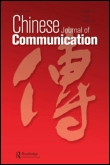
Chinese Journal of Communication
Unveiling Insights into the Evolving Landscape of Chinese CommunicationThe Chinese Journal of Communication, published by Routledge Journals, Taylor & Francis Ltd, has established itself as a pivotal platform for scholarly discourse in the field of communication, particularly within the context of Chinese media and its global interactions. With a notable Q1 ranking in the 2023 Communication category and a commendable Scopus ranking of #77 out of 511 journals, it represents a significant contributor to the advancement of communication studies. The journal's focus extends from theoretical frameworks to empirical research, fostering a comprehensive understanding of the evolving communication landscape. Available in both print (ISSN: 1754-4750) and digital formats (E-ISSN: 1754-4769), the journal does not operate on an Open Access basis, yet it remains a highly sought-after resource for researchers, professionals, and students aiming to explore communication phenomena from a Chinese perspective. Given its publication history converging from 2010 to 2024, it serves as a valuable reference point for ongoing academic investigations and is instrumental in shaping future research directions in this dynamic field.
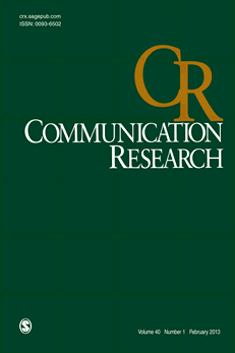
COMMUNICATION RESEARCH
Connecting Scholars through Rigorous Inquiry.COMMUNICATION RESEARCH, published by SAGE Publications Inc, stands as a premier journal in the fields of Communication and Linguistics, boasting an impressive impact factor that reflects its influential contributions to academic scholarship. Since its inception in 1974, this esteemed journal has provided rigorous, peer-reviewed research that delves into the dynamics of human communication, making it a vital resource for researchers, practitioners, and students alike. With a commendable ranking within the Q1 category for both Communication and Linguistics and consistently placed within the 99th percentile across Scopus ranks, COMMUNICATION RESEARCH is at the forefront of academic inquiry, fostering a deeper understanding of communication processes in diverse contexts. While not an Open Access journal, it offers extensive access options facilitating widespread dissemination of knowledge. Researchers can look forward to an engaging array of cutting-edge studies and theoretical advancements in forthcoming issues, making it an indispensable tool for those studying the complexities of language and communication.

Fonseca-Journal of Communication
Advancing Knowledge through Open Access ResearchFonseca-Journal of Communication, published by EDICIONES UNIV SALAMANCA in Spain, serves as a vital platform for the dissemination of scholarly research in the fields of Communication, Linguistics, and Social Sciences. Since its transition to Open Access in 2010, this journal has ensured that innovative ideas and research findings are accessible to a global audience, fostering knowledge exchange among researchers, professionals, and students alike. With an impressive ranking in various categories—Q3 in Communication, Q2 in Linguistics and Language, and Q3 in Social Sciences—the journal reflects its commitment to excellence and relevance in contemporary academic discourse. Its Scopus rankings confirm its growing impact in the linguistic and social research spheres, making it a valuable resource for those seeking to advance their understanding and contribute to scholarship in these fields. Through its rigorous peer-review process and diverse content, Fonseca aims to stimulate critical conversations and inspire future research.

Review of Communication Research
Fostering Open Dialogue in a Connected WorldReview of Communication Research is a prestigious open-access journal dedicated to advancing the field of communication studies. Published by REVIEW COMMUNICATION RESEARCH from its base in Madrid, Spain, this journal has established itself as a vital platform for scholarly discourse since its inception. With an impressive impact factor and ranked in the Q1 quartile of communication journals for 2023, it holds a commendable position, placing it within the top 13% of approximately 511 journals in the communication category on Scopus. Since becoming open-access in 2013, the journal has enabled researchers, professionals, and students to access high-quality research without financial barriers, thereby fostering a greater dissemination of knowledge and dialogue within the community. Covering a wide array of topics from communication theory to media studies, the Review of Communication Research continues to contribute significantly to the understanding and evolution of communication in today’s interconnected world. Researchers are encouraged to engage with and submit their findings to this influential journal to further enrich the scholarly landscape.

Frontiers in Communication
Pioneering Research for a Connected SocietyFrontiers in Communication is a prestigious open-access journal published by FRONTIERS MEDIA SA, dedicated to advancing the field of communication studies. Established in 2016 and situated in Switzerland, this journal has quickly ascended to notable ranks, achieving a Q1 category in both Communication and Social Sciences (miscellaneous) as of 2023. With an impressive Scopus rank, positioning it in the 75th and 78th percentiles for its respective categories, Frontiers in Communication serves as a vital platform for innovative research, interdisciplinary dialogue, and the dissemination of knowledge in the rapidly evolving landscape of communication. The journal emphasizes accessibility and intellectual exchange, providing an open-access format that ensures unrestricted access for researchers, professionals, and students alike. By fostering collaboration and exploration across various communication frameworks, Frontiers in Communication plays a crucial role in shaping the future discourse within the field.
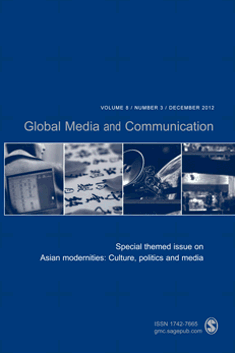
Global Media and Communication
Exploring the Nexus of Media and Communication WorldwideGlobal Media and Communication is a premier journal dedicated to advancing the fields of media and communication studies, published by SAGE Publications Ltd. With an ISSN of 1742-7665 and an E-ISSN of 1742-7673, this journal offers a platform for scholarly discourse and innovative research that explores the intricate relationships between global media practices and communication strategies. Recognized as a Q1 journal in both the Arts and Humanities (Miscellaneous) and Communication categories for 2023, it stands out in its commitment to delivering high-quality, peer-reviewed articles that contribute to the understanding of contemporary media landscapes. Located in London, United Kingdom, the journal benefits from being at the heart of cultural and digital innovation. Researchers, professionals, and students can look forward to insightful articles that not only critique existing frameworks but also propose new methodologies, ensuring that Global Media and Communication remains a vital resource for anyone interested in navigating the evolving dynamics of media and communication on a global scale.

Communitas
Unlocking New Insights in Socio-Linguistic ResearchCommunitas, published by the University of the Free State, is an esteemed open-access journal that has been a gateway for innovative research and discourse in the fields of communication, linguistics, and language since its inception in 2017. With an ISSN of 1023-0556 and E-ISSN of 2415-0525, the journal aims to foster scholarly exchange by providing a platform for critical analysis and interdisciplinary collaboration. Although it currently falls into Q4 in Communication and Q3 in Linguistics and Language, *Communitas* has made significant strides in establishing its presence in Scopus rankings—ranking 567 out of 1088 in Arts and Humanities and 397 out of 511 in Communication—and sources for researchers at varying stages of their careers. Addressed to a global readership, the journal invites contributions that enhance understanding and generate new perspectives on socio-linguistic issues and communicative practices, making it a pivotal resource for researchers, academics, and students committed to advancing knowledge in these dynamic fields.
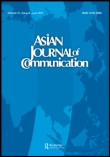
Asian Journal of Communication
Exploring Interdisciplinary Perspectives in CommunicationThe Asian Journal of Communication, published by Routledge Journals, Taylor & Francis Ltd, is a premier scholarly platform dedicated to advancing the field of communication studies. Established in 1990 and continuing its impactful publication journey through 2024, this esteemed journal caters to a broad spectrum of interdisciplinary research, addressing critical issues in communication, media, and education in an Asian context. With an impressive impact factor and ranked in the top quartiles in both Communication (Q1) and Education (Q2), the journal is recognized for its rigorous peer-review process and its commitment to quality scholarship. Researchers, professionals, and students can access invaluable insights and innovative research trends, helping to bridge gaps and foster understanding across diverse communication practices. The journal is accessible through institutional subscriptions and promotes global discourse, making it an essential resource for anyone engaged in the vibrant field of communication.
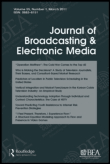
JOURNAL OF BROADCASTING & ELECTRONIC MEDIA
Engaging Scholars in Critical Media DiscourseThe JOURNAL OF BROADCASTING & ELECTRONIC MEDIA, published by Routledge Journals, Taylor & Francis Ltd, is a premier academic publication in the field of communication, officially recognized in the Q1 category for its exceptional quality and impact. With a rich history dating back to 1985, this journal serves as a vital platform for innovative research and critical discussions surrounding broadcasting and electronic media, addressing contemporary issues in digital communication, media technology, and audience studies. The journal boasts an impressive Scopus rank of #73 out of 511 in the Social Sciences - Communication category, placing it within the top 15% of its field. Researchers, professionals, and students alike benefit from its insightful articles that contribute to understanding the evolving landscape of media and communication. Although it does not currently operate under an Open Access model, its rigorous peer-review process ensures that published works meet high academic standards, sustaining its reputation as a cornerstone for scholarly discourse in the media industry.

International Journal of Communication
Elevating discourse in the field of communication.International Journal of Communication, published by USC Annenberg Press, is a premier open access journal dedicated to advancing the field of communication studies. Since its inception in 2007, the journal has provided a vital platform for researchers, professionals, and students to engage with cutting-edge research, theoretical frameworks, and empirical studies. With an impressive Q1 quartile ranking in Communication for 2023 and a notable Scopus rank of 156 out of 511 in the Social Sciences Communication category, the journal consistently contributes to high-quality scholarly discourse. It covers a wide array of topics, making it a crucial resource for those looking to stay informed about the latest developments in communication research. The journal's commitment to open access enhances its reach and impact, fostering a global community of academics and practitioners dedicated to exploring the complexities of communication in contemporary society. This makes the International Journal of Communication an essential read for anyone interested in understanding the dynamics of communication today.